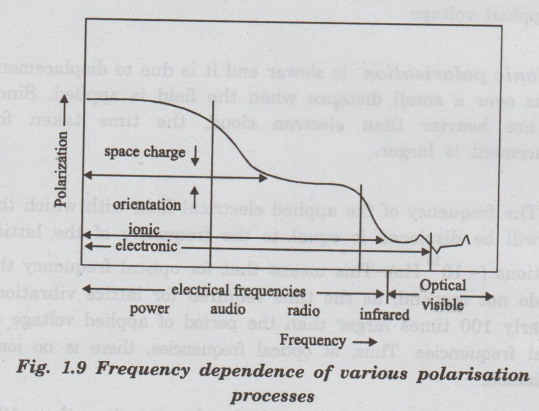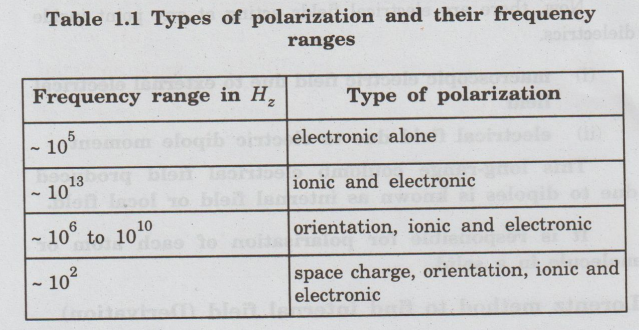Physics for Electrical Engineering: Unit I: Dielectric Materials and Insulation
Frequency Dependence of Polarization
Types and their frequency ranges, Comparison
The relaxation time tr is s measure of the time scale of polarisation process. It is the time taken for a polarisation process to reach 0.63 of the maximum value of polarization
FREQUENCY
DEPENDENCE OF POLARIZATION
When
an alternating field is applied across the material, the polarisation occurs as
a function time.
The
polarisation P (t) as a function of time t is given by
P(t)
=P [1- e (-t/tr)]
where
P - the maximum polarisation which occurs due to the static field applied for a
long time
tr
= relaxation time i.e., time taken for a particular polarisation process to
take place.
The
relaxation time tr is s measure of the time scale of
polarisation process. It is the time taken for a polarisation process to reach
0.63 of the maximum value of polarization
The
relaxation times are different for different kinds of polarisation mechanisms.
Frequency Dependence
(i) Electronic polarisation
is extremely rapid and is complete at any instant the voltage is applied. Thus,
even when the frequency of the applied voltage is very high in the optical
range (~ 1015 Hz), electronic polarisation occurs during every cycle
of the applied voltage
(ii) Ionic polarisation
is slower and it is due to displacement of ions over a small distance when the
field is applied. Since ions are heavier than electron cloud, the time taken
for displacement is larger.
The
frequency of the applied electrical field with which the ions will be displaced
is equal to the frequency of the lattice vibrations (~ 1013 Hz).
This means that for optical frequency the ions do not respond, as the time
required for lattice vibrations is nearly 100 times larger than the period of
applied voltage at optical frequencies. Thus, at optical frequencies, there is
no ionic polarisation.
If
the frequency of the applied voltage is less than 1013 Hz ie.,
infrared range, the ions have enough time to respond during each cycle of the
applied field (fig 1.9).

(iii) Orientation polarisation
is even slower than ionic polarisation. The relaxation time for orientation
polarisation changes with the type of dielectric materials (ie., solids or
liquids) used.
The
relaxation time for orientation polarisation in a liquid dielectric material is
less than in a solid dielectric material ie., the molecules in a liquid easily
reorient themselves compared to solids
Orientation
polarisation occurs only at electrical frequencies (audio and radio frequency)
range (≈ 106 Hz) as shown in figure
(iv) Space charge polarisation
is the slowest process since in this case ions have to diffuse (jump) over
several interatomic distances.
Space - charge polarisation occurs only at power frequencies (50-60 Hz) as shown in fig.1.9.
Therefore
from fig 1.9 it is noted that at low frequencies, all the four types of
polarisations present and the value of the total polarisation is very high
(maximum). The total polarisation value decreases with the increase in
frequency. Hence at high frequencies, the value of the polarisation is very
small (minimum)..)
Fig.
1.9 and Table 1.1 explains all the four types of polarization at different
frequency ranges.
Table 1.1 Types of polarization and
their frequency ranges

Table 1.2 Comparison of various
types of polarisation mechanisms

Physics for Electrical Engineering: Unit I: Dielectric Materials and Insulation : Tag: : Types and their frequency ranges, Comparison - Frequency Dependence of Polarization
Related Topics
Related Subjects
Physics for Electrical Engineering
PH3202 2nd Semester 2021 Regulation | 2nd Semester EEE Dept 2021 Regulation
